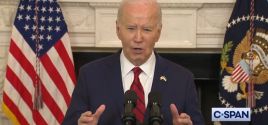
Newly released Census Bureau data for 2017 shows nearly half (48.2 percent) of residents in America's five largest cities now speak a language other than English at home. Overall, the number of U.S. residents speaking a foreign language at home reached a record of nearly 67 million. The total number is up seven million since 2010 and has increased by nearly 35 million since 1990.
Among the findings:
- In 2017, a record 66.6 million U.S. residents (native-born, legal immigrants, and illegal immigrants) ages five and older spoke a language other than English at home. The number has more than doubled since 1990, and almost tripled since 1980.
- As a share of the population, 21.8 percent of U.S. residents speak a foreign language at home -- roughly double the 11 percent in 1980.
- In America's five largest cities, 48 percent of residents now speak a language other than English at home. In New York City and Houston it is 49 percent; in Los Angeles it is 59 percent; in Chicago it is 36 percent; and in Phoenix it is 38 percent.1
- In 2017, there were 85 cities and Census Designated Places (CDP) in which a majority of residents spoke a foreign language at home. These include Hialeah, Fla. (95 percent); Laredo, Texas (92 percent); and East Los Angeles, Calif. (90 percent). Perhaps more surprisingly, it also includes places like Elizabeth, N.J. (76 percent); Skokie, Ill. (56 percent); and Germantown, Md., and Bridgeport, Conn. (each 51 percent).
- Nearly one in five U.S. residents now lives in a city or CDP in which one-third of the population speaks a foreign language at home. This includes Dale City, Va. (43 percent); Norwalk, Conn., and New Rochelle, N.Y. (each 42 percent); and Aurora, Colo., and Troy, Mich. (each 35 percent).
- In contrast to many of the nation's cities, in rural areas outside of metropolitan areas just 8 percent speak a language other than English at home.2
- The data released thus far indicates that nationally nearly one in four public school students now speaks a language other than English at home.3 In California, 44 percent of school-age (5-17) children speak a foreign language at home, and it's roughly one-third in Texas, Nevada, New Jersey, New York, and Florida.
- Of school-age children (5-17) who speak a foreign language at home, 85 percent were born in the United States. Even among adults 18 and older, more than one-third of those who speak a foreign language at home are U.S.-born.4
- Of those who speak a foreign language at home, 25.9 million (39 percent) told the Census Bureau that they speak English less than very well. This figure is entirely based on the opinion of the respondent; the Census Bureaus does not measure language skills.5
- Of languages with more than 400,000 speakers in 2017, the largest percentage increases from 2010 to 2017 were among speakers of Telugu (up 86 percent); Arabic (up 42 percent); Hindi (up 42 percent); Urdu (up 30 percent); Chinese (up 23 percent); Gujarati (up 22 percent); and Haitian Creole (up 19 percent). Hindi, Telugu, and Gujarati are spoken in India, and Urdu is the national language of Pakistan.
- The largest numerical increases from 2010 to 2017 were among speakers of Spanish (up four million); Chinese (up 653,000); Arabic (up 363,000); Hindi (up 254,000); Telugu (up 192,000); Tagalog (up 173,000); Haitian Creole (up 140,000); Bengali (up 128,000); Urdu (up 118,000); and Vietnamese (up 117,000). Telugu and Tamil are spoken in India, Tagalog is the national language of the Philippines, and Bengali is spoken in India and is also the national language of Bangladesh.
- Languages with more than a million speakers in 2017 were Spanish (41 million); Chinese (3.5 million); Tagalog (1.7 million); Vietnamese (1.5 million); Arabic (1.2 million); French (1.2 million); and Korean (1.1 million).
- States with the largest share of their populations speaking a foreign language at home in 2017 were California (44 percent); Texas (36 percent); New Mexico (33 percent); New Jersey (32 percent); New York and Nevada (both 31 percent); Florida (30 percent); Arizona (27 percent); Hawaii (26 percent); and Massachusetts (24 percent).
- States with the large percentage increase in the number of foreign language speakers from 2010 to 2017 were Wyoming (up 33 percent); North Dakota (up 30 percent); Utah (up 25 percent); Delaware (up 24 percent); Nevada (up 22 percent); Maryland, Nebraska, Kentucky, and Florida (each up 21 percent); and Minnesota (up 19 percent).
- Taking the longer view, states with the largest percentage increase in foreign language speakers from 1980 to 2017 were Nevada (up 1,080 percent); Georgia (up 945 percent); North Carolina (up 771 percent); Virginia (up 488 percent); Tennessee (up 441 percent); Arkansas (up 428 percent); Washington (up 410 percent); Florida (up 384 percent); South Carolina (up 379 percent); Utah (up 368 percent); and Oregon (up 356 percent).
Data Source. In September of this year, the Census Bureau released some of the data from the 2017 American Community Survey (ACS). The survey reflects the U.S. population as of July 1, 2017. The ACS is by far the largest survey taken by the federal government each year and includes over two million households.6 The Census Bureau has posted some of the results from the ACS to American FactFinder on the Bureau website.7 It has not released the public-use version of the ACS for researchers to download and analyze. However a good deal of information can be found at FactFinder. Unless otherwise indicated, the information in this analysis comes directly from FactFinder.
Read More
|









